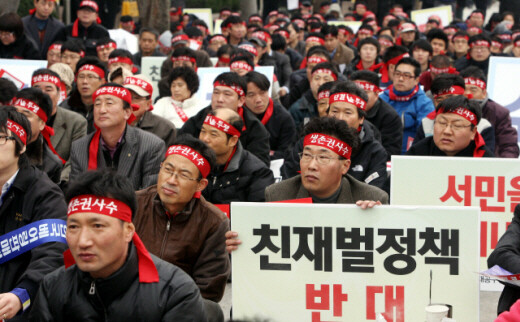hankyoreh
Links to other country sites 다른 나라 사이트 링크
Smaller businesses carry heavier tax burden, study says

By Hwangbo Yeon
Analysis from a research report reveals that tax benefits over the last 20 years have concentrated on the leading businesses of major corporations. As a result, there is almost no difference in the tax burden of large and small to medium-sized businesses, and since 2004, the tax burden on small to medium-sized businesses has actually been greater.
According to a report by the Economic Reform Research Institute (ERRI) analyzing effective corporate tax rate on listed companies from 1990 to 2009, the average effective tax rate on domestic listed corporations fell continuously from 1990 to last year. The rate dropped from 33.16 percent to 17.01 percent. The report analyzed 1,619 non-bank companies listed as of the end of June on standard securities markets and the KOSDAQ.
The effective corporate tax rate is the ratio of taxes against a company’s net income. It differs from the nominal tax rate because it shows the actual tax burden on a company, taking into consideration the variety of tax cuts and tax credits. In fact, between 1990 and 2009, the average effective tax rate was 6.25 percentage points lower than the nominal tax rate, and since 2000, the gap has grown to 8.04 percentage points.
If you compare the effective tax rate over the last 20 years by industry, the average tax rate on manufacturing industries was the lowest at 22.52 percent. Compared to the average for total industries (24.66 percent), this was a much lower figure and shows that tax benefits concentrated on manufacturing. On the other hand, the tax burden was relatively high on construction companies (32.18 percent), whole and retail sellers (29.23 percent), business support services (29.65 percent) and educational services (35.92 percent).
Among manufacturers, the tax burden was lightest on electrical, electronics and telecom equipment companies (16.80 percent). Next came primary metal working businesses such as steel firms (21.86 percent) and transportation equipment, represented by car and ship builders (22.89 percent). Compared with this, the actual tax rate on industries with high numbers of small to medium-sized businesses such as metal parts producers (29.85 percent), precision machines (27.66 percent) and other machines (24.43 percent) was higher than the average for manufacturing. ERRI concluded that this shows that the government’s tax policy support has leaned toward South Korea’s leading export industries and the major businesses of major corporations.
In particular, the report shows that despite an array of tax support articles for small to medium-sized businesses, at least on paper, major corporations have been enjoying more actual tax benefits.
Over the first 20 years, the gap in the effective corporate tax rates of small to medium-sized businesses (300 employees or less) and major corporations was just 0.87 percentage points, but in the last 10 years it has narrowed even further to 0.71 percent. In particular, between 2004 and 2008, the tax burden on small to medium-sized businesses was larger than that on major companies. This was the result of tax benefits for investment into technology and R&D as well as tax benefits for corporate restructuring concentrating on large corporations.
Moreover, the tax burden on the top 10 companies in terms of market capitalization was 22.1 percent, 2.6 percentage points lower than the total industrial average, 0.4 percentage points lower than the average for manufacturers, and 2.7 percentage points lower than the average for large companies as a whole. The effective tax rate on LG Display and Samsung Electronics over the last five years was 13.1 percent and 14.1 percent, respectively.
Please direct questions or comments to [englishhani@hani.co.kr]
Editorial・opinion
![[Column] Season 2 of special prosecutor probe may be coming to Korea soon [Column] Season 2 of special prosecutor probe may be coming to Korea soon](https://flexible.img.hani.co.kr/flexible/normal/500/300/imgdb/original/2024/0426/3317141030699447.jpg) [Column] Season 2 of special prosecutor probe may be coming to Korea soon
[Column] Season 2 of special prosecutor probe may be coming to Korea soon![[Column] Park Geun-hye déjà vu in Yoon Suk-yeol [Column] Park Geun-hye déjà vu in Yoon Suk-yeol](https://flexible.img.hani.co.kr/flexible/normal/500/300/imgdb/original/2024/0424/651713945113788.jpg) [Column] Park Geun-hye déjà vu in Yoon Suk-yeol
[Column] Park Geun-hye déjà vu in Yoon Suk-yeol- [Editorial] New weight of N. Korea’s nuclear threats makes dialogue all the more urgent
- [Guest essay] The real reason Korea’s new right wants to dub Rhee a founding father
- [Column] ‘Choson’: Is it time we start referring to N. Korea in its own terms?
- [Editorial] Japan’s rewriting of history with Korea has gone too far
- [Column] The president’s questionable capacity for dialogue
- [Column] Are chaebol firms just pizza pies for families to divvy up as they please?
- [Column] Has Korea, too, crossed the Rubicon on China?
- [Correspondent’s column] In Japan’s alliance with US, echoes of its past alliances with UK
Most viewed articles
- 1‘We must say no’: Seoul defense chief on Korean, USFK involvement in hypothetical Taiwan crisis
- 2[Column] Season 2 of special prosecutor probe may be coming to Korea soon
- 3N. Korean delegation’s trip to Iran shows how Pyongyang is leveraging ties with Moscow
- 4Amnesty notes ‘erosion’ of freedom of expression in Korea in annual human rights report
- 5[Reportage] On US campuses, student risk arrest as they call for divestment from Israel
- 6Korea sees more deaths than births for 52nd consecutive month in February
- 7[Editorial] New weight of N. Korea’s nuclear threats makes dialogue all the more urgent
- 8‘Weddingflation’ breaks the bank for Korean couples-to-be
- 9[Column] Has Korea, too, crossed the Rubicon on China?
- 10[Column] Park Geun-hye déjà vu in Yoon Suk-yeol